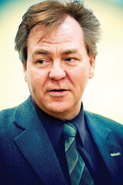Sigma Xi lecture on working in space
Sigma Xi lecture on working in space McGill University
User Tools (skip):
Sigma Xi lecture on working in space

Bjarni Tryggvason.
Claudio Calligaris
The McGill chapter of the scientific research society Sigma Xi reached for the stars when they invited their guest lecturer for April 15. Canadian astronaut Bjarni Tryggvason was delighted to talk to Sigma Xi members about the need for basic space research, as well as respond to earthbound curiosity about what it's like to be beyond Earth.
Tryggvason was one of six Canadian astronauts aboard the Space Shuttle Discovery in 1997. During his 12 days on the flight, he performed fluid science experiments in the low gravity environment of space. These were to better understand the effect of spacecraft vibrations on tests done on the International Space Station (ISS). He also tested the Microgravity Vibration Isolation Mount (MIM), a device designed to provide a platform for experiments to be done vibration-free. The MIM, of which he was principal investigator, operated on the Russian space station, Mir.
"There are a lot of naïve assumptions by scientists," the cheerful Tryggvason said. "People say there is no gravity, no drag — that in space it's the 'perfect' environment."
But there are vibrations from the spacecraft ("g-jitters") and from the people on board. As well, however small it may be, there is still gravitational force. The ISS is only as far above the Earth's surface as roughly the distance from Montreal to Ottawa. "You'd have to get 10 million kilometres from Earth to get the real microgravity environment," he said.
Working in space, Tryggvason said, "is not the ideal disturbance-free environment that the community expected." Rather it's "like a big bowl of jello — it jiggles a little bit, and vibrates a lot."
Tryggvason's experiments focused on Brownian motion (the seemingly random movement of tiny particles immersed in fluid). Before going into orbit, he'd been reading Subtle is the Lord, a book on Einstein, as well as his mathematical work on the motion, and Tryggvason wanted to see if it was possible to get rid of the microvibrations at the boundary of a container. Ultimately, he saw vibrations where the substance was supposed to move as if rigid.
He showed slides of other contemporary experiments to the audience. University of Toronto researcher Charles Ward wondered how liquid would disperse in a closed container in space, something that no one had thought to verify in decades of space research. A glass may be half-full or half-empty up there, as it is on Earth, but obviously the liquid wouldn't fall to the "bottom." Ward guessed it would settle on both the top and bottom, with vapour between the two fluid parts, which was proven correct. And oddly, the curve of the meniscus was different at each end, thanks to subtle pressure differences on the fluid.
Other experiments done on personal time yielded astonishing results. One astronaut formed water balls in space with the aid of a three-inch-diameter loop of piano wire, and used a syringe to slowly inject an inch-and-a-half-round air bubble. He then slipped in a droplet of water or two to observe the movement within the bubble. He saw much more vigorous ricochets and trajectories than anyone would have predicted.
Unexpected results like these highlight the grossly incorrect assumptions that have been made by scientists. Despite 112 NASA research flights, adding up to roughly three full years of space experience, little rigorous science can come of their experiments. "We're skipping over too many things, not taking our time," Tryggvason lamented. "But once we [take more care], we'll see interesting things."
A thorough understanding of basic physical principles in space will help scientists with a range of questions on subjects from osteoporosis (astronauts lose from one to one-and-a-half percent of their bone mass every month in space, which takes two to three years to recover once back on Earth) to growing protein crystals (of 700 samples on board the ISS, half grew better than expected and half did worse).
In response to questions from the audience about what it felt like to be in space, Tryggvason said that without the normal pull of gravity, the fluids in your body shift. He spent the whole time feeling like he had a cold because his head was stuffed up. To make up for losing 15 percent of their fluid, before returning to terra firma astronauts drink two quarts of salty water.
For 12 days Tryggvason worked under the unusual conditions of next-to-no-gravity. He had to hold himself in place to his laptop by his pinkies. He feels "incredibly lucky" to have been in space, and laments he was so immersed in his work that he didn't take enough time to gaze out the window at the glorious, rare view of Earth. He said they were going by so quickly — around the globe in 90 minutes — that he'd look out at Hudson's Bay and remind himself to check for Vancouver, his home, in a few minutes or he'd miss it.
Seventy percent of astronauts get motion sickness, but only a couple of the 400 space travellers over 20 years were too sick to function for a few days. Most "just get over the barfing and get on with their work," Tryggvason said.
Hand-eye coordination is also disturbed on board, because astronauts don't have the familiar body sensation cues, such as air resistance against their skin. Tryggvason also had the disturbing experience of having two "ups": the sensation of up coming out of the back of his head, and then seeing the ceiling in front of him.
He also had to sleep in a sleeping bag so he wouldn't float all over the place, and found himself feeling the need to "roll over" now and again before falling asleep. At first he'd tie a pillow to the back of his head, "then I realized, why am I doing this?" he laughed.
